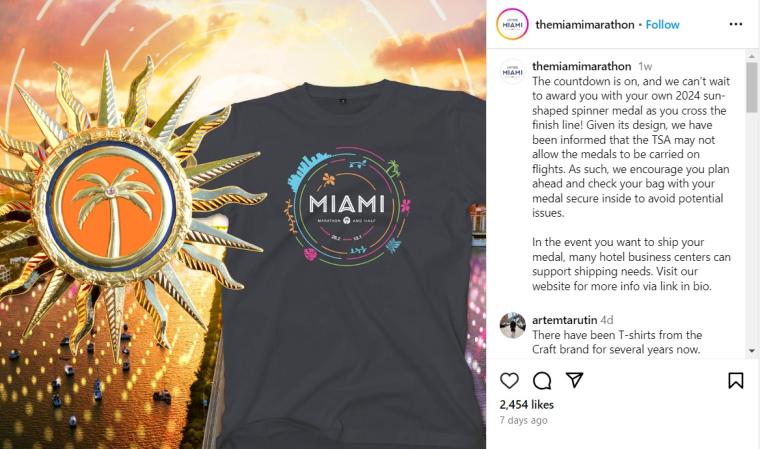
In this social media post, organizers of the Miami Marathon and Half revealed the 2024 medal but noted it could be a security risk; below in this article is an image of the device it is said by TSA to resemble.
Do we now need (wait for it) MEDAL DETECTORS in airports?
SDM has been covering the business of sports travel for a long time and this is a new one. Multiple runners completed a destination marathon, and while traveling home, had their medals confiscated and thrown away by TSA because they looked too much like weapons.
The saga started on January 28 when runners took part in the Miami Marathon and Half Marathon. As they crossed the finish line, athletes were awarded a medal shaped like the sun. (An image of it, taken from the event's social media account, is shown above.)
Appropriate, right? After all, this is a destination that prides itself on its great (sunshiny) weather, making it one of the reasons people want to participate in the dead of winter.
Nope, definitely not appropriate, said TSA, who confiscated multiple medals as runners went through security checkpoints.
Apparently, the medals were interpreted as star-shaped devices, known as “ninja throwing stars.” And throwing stars are on the TSA’s list of prohibited items alongside other ninja-approved weapons like nunchucks, swords, sai, and axes. (Note: An image of a throwing star is included in this article for comparison purposes.)
Setting aside nunchucks and swords, how did medals wind up on the no-fly list – and how did race organizers not know in advance (and warn runners their medals were a flight risk)?
Turns out, event owners did warn athletes in advance; in fact, they told Runner’s World that the information had been sent out to all registered participants in a pre-race e-mail, which includes the following verbiage:
“The countdown is on, and we can’t wait to award you with your own 2024 sun-shaped spinner medal as you cross the finish line! Given its design, we have been informed that the TSA may not allow the medals to be carried on flights. As such, we encourage you to plan ahead and check your bag with your medal secure inside to avoid potential issues.” (A copy of the Instagram post, with this noted, is available here.) The event owners also noted, "In the event you want to ship your medal, many hotel business centers can support shipping needs. Visit our website for more info via link in bio."

“This was proactive on our end,” Frankie Ruiz, the Race Director told the Miami Herald (in a quote picked up by Runner’s World). “Once we got the initial batch of medals, we were like, ‘Hey you know what? Someone could misinterpret this.’ I can think of other medals, even ours throughout the years, that have sharp edges or they have corners or whatnot and people wear them to the airports.”
SDM was unable to locate any information on other medals that had been confiscated by TSA. (This is not to say there have not been such medals; the current news about the Miami medal has pushed every other search entry out of the way.)
However, in its defense, TSA has had to confiscate a lot of weird stuff throughout the years. (Giraffe manure being one of those.) And many of the rules apply only to carry-on baggage but not to checked baggage, something marathon runners in Miami would have benefitted by remembering, as per the warning in the email.
Canadian Running points out, "Each year, more than 4,000 of the 18,000 participants travel to the race by plane from 49 states and 75 countries. Although the TSA website states that it allows carry-on items such as cowboy spurs, ice skates, antlers, knitting needles, cigar cutters, corkscrews, bowling balls and even fidget spinners, TSA agents have final discretion over what can be allowed on flights."
Many medals have edges that could be deemed as sharp; for example, in 2022, the medal for the Baltimore Marathon was in the shape of a blue crab, a delicacy on which Maryland prides itself. (But all things considered, it’s likely not throwable, given its irregular shape.)
Bottom line (at least in terms of sports medals): Anything can be considered a weapon these days, and event owners will be well-served to take under advisement the TSA guidelines during the design phase. After all, even if it is unlikely marathon finishers will use something as a weapon, that does not sway TSA, and it won't retract the bad publicity. And with race participation edging back up to pre-pandemic levels, it's likely more people will be traveling to destination races.
The question now, apparently, is whether the Miami event will mail medals to those whose bling was confiscated in the airport. (It might be, all things considered, the only path to satisfying finishers and bringing them back for another year.)

